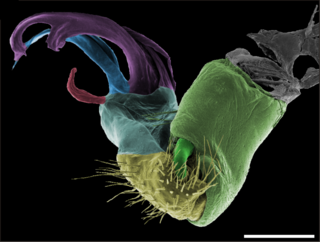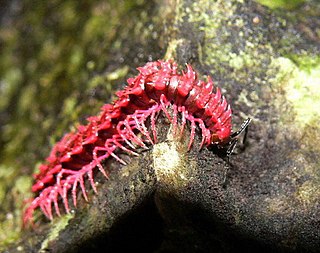
Gonopods are specialized appendages of various arthropods used in reproduction or egg-laying. In males, they facilitate the transfer of sperm from male to female during mating, and thus are a type of intromittent organ. In crustaceans and millipedes, gonopods are modified walking or swimming legs. Gonopods may be highly decorated with elaborate structures which may play roles in sperm competition, and can be used to differentiate and identify closely related species. Gonopods generally occur in one or more pairs, as opposed to the single (un-paired) reproductive organs such as the aedeagus of insects or the penis of harvestmen.

Harpaphe haydeniana, commonly known as the yellow-spotted millipede, almond-scented millipede or cyanide millipede, is a species of polydesmidan ("flat-backed") millipede found in the moist forests along the Pacific coast of North America, from Southeast Alaska to California. The dark coloration with contrasting yellow-tipped keels warn of its ability to exude toxic hydrogen cyanide as a defense. The cyanide secretions are not dangerous to humans, but can cause irritation and pain if it contacts sensitive areas such as the mouth, eyes, or nose.

Desmoxytes, whose species are commonly known as the dragon millipedes, is a genus of millipedes of the family Paradoxosomatidae found in Southeast Asia. The genus was described by Ralph Vary Chamberlin in 1923, and reviewed by Sergei Golovatch and Henrik Enghoff in 1994. At least 18 species are known from to Malaysia, Myanmar, and Thailand. One species, D. planata, has also been observed in Sri Lanka, the Andaman Islands, Seychelles, Java, Great Coco Island, and Fiji; however, this species has expanded its range by being transported through human activity. Several species have only recently been discovered, and some have yet to be officially described.
Desmoxytoides hasenpuschorum is a species of millipede and the only species in the monotypic genus Desmoxytoides. It lives in Australia. This species is closely related to the dragon millipedes of the genus Desmoxytes, and there is some speculation, even by Robert Mesibov, the genus authority, that the split may not be necessary. While Desmoxytoides hasenpuschorum is similar to the millipedes of Desmoxytes in paranotal form and metatergite sculpture, it has a simpler gonopod telopodite with an unprotected solenomere which gives it its own monotypic genus. This species has the ability to produce hydrogen cyanide to ward off predators.

Polydesmida is the largest order of millipedes, containing approximately 3,500 species, including all the millipedes reported to produce hydrogen cyanide (HCN). Polydesmids grow and develop through a series of moults, adding segments until they reach a fixed number in the adult stage, which is usually the same for a given sex in a given species, at which point the moulting and the addition of segments and legs stop. This mode of development, known as teloanamorphosis, distinguishes this order from most other orders of millipedes, which usually continue to moult as adults, developing through either euanamorphosis or hemianamorphosis.
Hylomus is a genus of millipede of the family Paradoxosomatidae found in southeast Asia.

Paradoxosomatidae, the only family in the suborder Paradoxosomatidea, is a family of flat-backed millipedes in the order Polydesmida. Containing nearly 200 genera and 975 species as of 2013, it is one of the largest families of millipedes. Paradoxosomatids occur on all continents except Antarctica, and can generally be distinguished by dorsal grooves on most body segments and a dumb-bell shaped gonopod aperture. Notable groups within the Paradoxosomatidae include the dragon millipedes of Southeast Asia, and the widely introduced greenhouse millipede Oxidus gracilis.
Antichiropus is a genus of millipede in the family Paradoxosomatidae. The genus is very distinctive in the form of the gonopod, which is typically coiled through at least a full circle. It is probably endemic to Australia. Some species have small ranges of less than 10000 km2, classifying them as short-range endemic invertebrates.

Casimir Albrecht Willem Jeekel (1922–2010) was a Dutch myriapodologist and entomologist known for his major contributions to the taxonomy of millipedes. His 1971 monograph Nomenclator Generum et Familiarum Diplopodorum is credited as launching the "modern era" of millipede taxonomy, and has been considered the "most important single work ever published on the Diplopoda". He served as director of the Zoological Museum Amsterdam, and authored over 150 works on the taxonomy of millipedes and other myriapods.

Chamberlinius is a genus of flat-backed millipedes in the family Paradoxosomatidae. There are five species; 3 of which occur only Taiwan, one only in the Ryukyu Islands of southeast Japan, and one occurring in both areas. Individuals are 25–37 mm (0.98–1.46 in) long and up to 5.5 mm wide, colored in pale yellow to brown, sometimes with dark brown markings on the anterior portion of body segments.

Boreohesperus is a genus of paradoxosomatid millipedes containing six species native to Western Australia. The name refers to the northwestern distribution in Australia, deriving from Boreas, Greek god of the North, and hesperus, Latin for "west".

Anoplodesmus anthracinus is a species of millipedes in the family Paradoxosomatidae. It was previously thought to confined to Myanmar, the species was reported and documented from Malaysia and Sri Lanka in 2013.
Anoplodesmus humberti is a species of millipede in the family Paradoxosomatidae. It is endemic to Sri Lanka, which was first documented from Peradeniya.
Anoplodesmus layardi is a species of millipedes in the family Paradoxosomatidae. It is endemic to Sri Lanka, which was first documented from Peradeniya.
Anoplodesmus luctuosus is a species of millipedes in the family Paradoxosomatidae. It is endemic to Sri Lanka, which was first documented from Ramboda. The species sometimes placed in the genus Polydesmus of the family Polydesmidae.
Anoplodesmus inornatus, is a species of millipedes in the family Paradoxosomatidae. It is endemic to Sri Lanka, which was first documented from Peradeniya.
Anoplodesmus sabulosus, is a species of millipedes in the family Paradoxosomatidae. It is endemic to Sri Lanka, which was first documented from Kandy.

Anoplodesmus saussurii is a species of millipedes in the family Paradoxosomatidae. It was once thought endemic to Sri Lanka, but it was later found in Fiji and Mauritius.
Chondromorpha xanthotricha, is a species of millipedes in the family Paradoxosomatidae. It is native to South India and Sri Lanka. Two subspecies recognized.

Desmoxytes golovatchi, is a species of millipede in the family Paradoxosomatidae, that can be found in Thailand.










